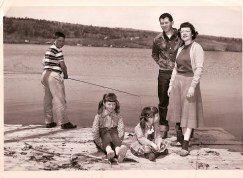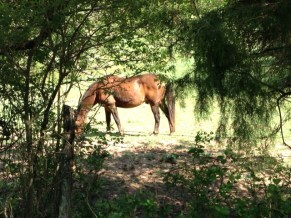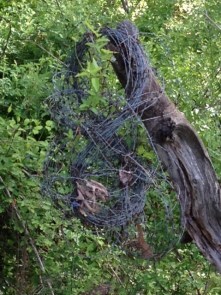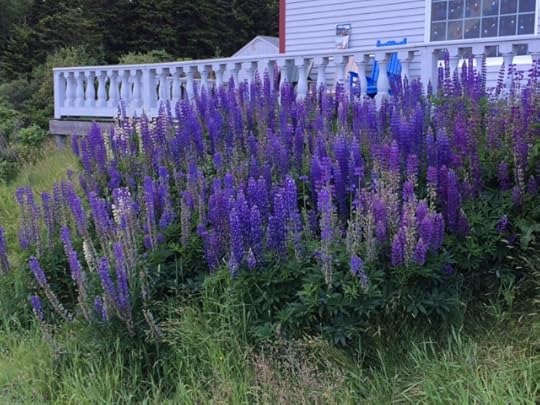What a Writer Can Learn from a Spring Garden
Kate Flora: I was going to write a post today about voice in our fiction, but I got bogged down in references and watching YouTube videos and taking notes. I got frustrated and headed out to the garden, which is always a great place to take my frustrations.
 The way that writers see the world is a subject I return to fairly often, as you faithful readers may have noticed. Shapes and shadows, colors and textures. People and the odd things they do and say. Spring is the season that I slip away to the garden as often as I can and focus my noticing on the plants and shrubs. I love watching tiny shoots of green grow taller every day until they become large, lush plants with the promise of flowers ahead. I like to prowl along the edge of the perennial bed, looking for those tiny volunteers that have escaped and are trying to survive in the grass of the lawn. After admiring their tenacity,I dig them up and find them new places to grow.
The way that writers see the world is a subject I return to fairly often, as you faithful readers may have noticed. Shapes and shadows, colors and textures. People and the odd things they do and say. Spring is the season that I slip away to the garden as often as I can and focus my noticing on the plants and shrubs. I love watching tiny shoots of green grow taller every day until they become large, lush plants with the promise of flowers ahead. I like to prowl along the edge of the perennial bed, looking for those tiny volunteers that have escaped and are trying to survive in the grass of the lawn. After admiring their tenacity,I dig them up and find them new places to grow.
What do these shoots of green and shades of green that seem to change overnight teach

My mother, and writing and gardening inspiration, A. Carman Clark in her garden
me? Perhaps about how this is much like the way a book begins. First it is just a tiny idea, and by pondering on it, it gradually grows to become the plot of a book. Like those tiny shoots, a book idea needs attention. It needs to be fertilized with essential questions like: What is this story about? Who are the central characters and why is the book about this particular set of characters? Just as I will struggle to identify plants when they are tiny, knowing whose story it will be is critical to the thinking and planning that lies ahead.
As with plants, the story will need space to grow to its full size, in the brain and on the page. It will need the unnecessary ideas to be weeded out or transplanted to another place in the story so that the plant can grow. Sometimes it will need to be cut back to make the plot fuller and less straggly.

April at a writing retreat in Virginia. I pass this horse on the way to my studio
Like a tender plant needing a gardener to tend it, a book idea needs the author to figure out what the story needs to make it grow into a successful book. What will fertilize it? How much water (or perhaps, in an author’s case, how much alcohol) will it need to make it grow and achieve its full potential? What kind of research must be done to make the setting, characters, and plot feel authentic to a reader. And as in a successful garden, the plant, like a protagonist or antagonist, will need complimentary plants around it to illuminate it and compliment it. What complimentary shapes and sizes and colors will enhance a perennial bed? What sidekicks, bosses, clients, or love interests will shape and enhance your protagonist?
Often, as well, a plant will have other plants around it that will thwart its growth. And of

sometimes you have to get through the tangle
course, in any garden where there will be weeds, roots, rocks, and pests that will impede its successful growth to a mature plant. Similarly, in our fiction, there will be the obstacles internal and external, and the antagonists, both natural and human, which must be overcome in order for the story to thrive and develop and come to a successful conclusion where order is restored to the world.
Finally, like a well-told story successfully brought to its conclusion, there is the moment in the garden when a plant that has been successfully fertilized, watered, and protected from weeds and insects, fulfills its purpose by producing colorful leaves and glorious flowers. With the book, that is the moment when the writer types: The End, and sits back with a smile of satisfaction.
Of course, just as in a well-tender garden where plants need to be divided, cut back, staked, or shuffled around to new locations, for the writer’s story, generally typing: The End is not the end. It is simply the beginning of the next process: revision. And in the process, the garden reminds us that every part of the process needs our attention, and rewards it, with blooms or a finished book.
So happy spring, readers and writers. May your words flow and your garden grow!

Lea Wait's Blog
- Lea Wait's profile
- 508 followers



